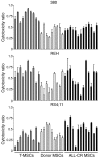Mesenchymal cells regulate the response of acute lymphoblastic leukemia cells to asparaginase
- PMID: 17380207
- PMCID: PMC1821067
- DOI: 10.1172/JCI30235
Mesenchymal cells regulate the response of acute lymphoblastic leukemia cells to asparaginase
Abstract
Because of their low asparagine synthetase (ASNS) expression and asparagine biosynthesis, acute lymphoblastic leukemia (ALL) cells are exquisitely sensitive to asparagine depletion. Consequently, asparaginase is a major component of ALL therapy, but the mechanisms regulating the susceptibility of leukemic cells to this agent are unclear. In 288 children with ALL, cellular ASNS expression was more likely to be high in T-lineage ALL and low in B-lineage ALL with TEL-AML1 or hyperdiploidy. However, ASNS expression levels in bone marrow-derived mesenchymal cells (MSCs), which form the microenvironment where leukemic cells grow, were on average 20 times higher than those in ALL cells. MSCs protected ALL cells from asparaginase cytotoxicity in coculture experiments. This protective effect correlated with levels of ASNS expression: downregulation by RNA interference decreased the capacity of MSCs to protect ALL cells from asparaginase, whereas enforced ASNS expression conferred enhanced protection. Asparagine secretion by MSCs was directly related to their ASNS expression levels, suggesting a mechanism - increased concentrations of asparagine in the leukemic cell microenvironment - for the protective effects we observed. These results provide what we believe to be a new basis for understanding asparaginase resistance in ALL and indicate that MSC niches in the bone marrow can form a safe haven for leukemic cells.
Figures







References
-
- Oettgen H.F., et al. Inhibition of leukemias in man by L-asparaginase. Cancer Res. 1967;27:2619–2631. - PubMed
-
- Tallal L., et al. E. coli L-asparaginase in the treatment of leukemia and solid tumors in 131 children. Cancer. 1970;25:306–320. - PubMed
-
- Pratt C.B., Simone J.V., Zee P., Aur R.J., Johnson W.W. Comparison of daily versus weekly L-asparaginase for the treatment of childhood acute leukemia. J. Pediatr. 1970;77:474–483. - PubMed
-
- Jaffe N., et al. L-asparaginase in the treatment of neoplastic diseases in children. Cancer Res. 1971;31:942–949. - PubMed
-
- Sutow W.W., et al. L-asparaginase therapy in children with advanced leukemia. The Southwest Cancer Chemotherapy Study Group. Cancer. 1971;28:819–824. - PubMed
Publication types
MeSH terms
Substances
Grants and funding
LinkOut - more resources
Full Text Sources
Other Literature Sources

